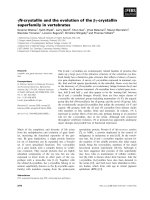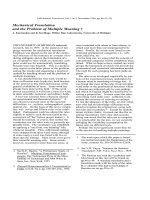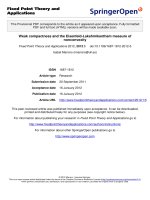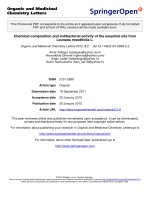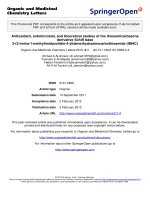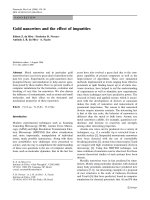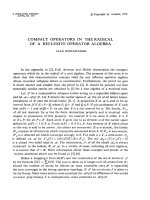Báo cáo toán học: " Mesh patterns and the expansion of permutation statistics as sums of permutation patterns" docx
Bạn đang xem bản rút gọn của tài liệu. Xem và tải ngay bản đầy đủ của tài liệu tại đây (226.47 KB, 14 trang )
Mesh patterns and the expansion of permutation
statistics as sums of permutation patterns
Pett er Br¨and´en
∗
Department of Mathematics, Stockholm University,
SE-106 91 Stockholm, Sweden
Anders Claesson
†
Department of Computer and Information Sciences,
University of Strathclyde, Glasgow, G1 1XH, UK
Submitted: Feb 21, 2011; Accepted: Mar 3, 2011; Published: Mar 15, 2011
Mathematics Subject Classification: 05A05, 05A15, 05A19
Dedicated to Doron Zeilberger on the occasion of his sixtieth birthday
Abstract
Any permutation statistic f : S → C may be represented uniquely as a, possibly
infinite, linear combination of (classical) permutation patterns: f = Σ
τ
λ
f
(τ)τ. To
provide explicit expansions for certain statistics, we introduce a new type of permu-
tation patterns that we call mesh patterns. Intuitively, an occurrence of the mesh
pattern p = (π, R) is an occurrence of the permutation pattern π with additional
restrictions specifi ed by R on the relative position of the entries of the occurrence.
We show that, for any mesh p attern p = (π, R), we h ave λ
p
(τ) = (−1)
|τ |−|π|
p
⋆
(τ)
where p
⋆
= (π, R
c
) is the mesh pattern with the same underlying permutation as
p but with complementary restrictions. We use this resu lt to expand some well
known permutation statistics, such as the number of left-to-right maxima, descents,
excedances, fixed points, strong fixed points, and the major index. We also show
that alternating permutations, Andr´e permutations of the first kind and simsun p er-
mutations occur naturally as permutations avoiding certain mesh patterns. Finally,
we provide new natural Mahonian statistics.
∗
PB is a Royal Swedish Academy of Sciences Research Fellow supported by a grant from the Knut
and Alice Wallenberg Foundation.
†
AC was supported by grant no. 090038011 from the Icelandic Research Fund.
the electronic journal of combinatorics 18(2) (2011), #P5 1
1 Introduction
1.1 Mesh patterns
Let [a, b] be the integer interval {i ∈ Z : a ≤ i ≤ b}. Denote by S
n
the set of permutations
of [1, n]. A mesh pattern is a pair
p = (π, R) with π ∈ S
k
and R ⊆ [0, k] × [0, k].
An example is p =
3241, {(0, 2), (1, 3), (1, 4), (4, 2), (4, 3)}
. To depict t his mesh pattern
we plot the points (i, π(i)) in a Cartesian coordinate system, and for each (i, j) ∈ R we
shade the unit square with bottom left corner (i, j):
Let p = (π, R) be a mesh pattern with k = |π|, where |π| denotes the number of
letters in π, and let τ ∈ S
n
. We will think of p as a function on permutations that counts
occurrences of p. Intuitively, p(τ) is the number of “classical” occurrences of π in τ with
additional restrictions on the relative position of the entries of the occurrence of π in τ.
These restrictions say that no elements of τ are allowed in the shaded regions of the figure
above. Formally, an occurrence of p in τ is a subset ω of the plot of τ, G(τ) = {(i, τ(i)) :
i ∈ [1, n]}, such that there are order- preserving injections α, β : [1, k] → [1, n] satisfying
two conditions that we shall now describe. The first condition is that ω is an occurrence
of π in the classical sense. That is,
(i) ω =
(α(i), β(j)) : (i, j) ∈ G(π)
.
Define R
ij
= [α(i) + 1, α(i + 1) − 1] × [β(j) + 1, β(j + 1) − 1] for i, j ∈ [0, k], where
α(0) = β(0) = 0 and α(k + 1) = β(k + 1) = n + 1. Then the second condition is
(ii) if (i, j) ∈ R then R
ij
∩ G(τ) = ∅.
Classical [10], vincular [2] and bivincular [4] patterns can all be seen as special mesh
patterns: p = (π, R) is a classical pattern if R = ∅; p is a vincular pattern if R is a union
of vertical strips, {i} × [0, |π|]; p is a bivincular pattern if R is a union of vertical strips
and horizontal strips, [0, |π|] × {i}. An example is provided by the following bivincular
pattern which has been studied by Bousquet-M´elou et al. [4]:
231, [0, 3]×{1} ∪ {1}×[0, 3]
= .
It is also easy to write any barred pattern [14] with only one barred letter as a mesh
pattern. Indeed, if π(i) is the only barred letter of a given barred pattern π, then the
corresponding mesh pattern is (π
′
, {(i − 1, π(i) − 1)}, where π
′
is obtained from π by
the electronic journal of combinatorics 18(2) (2011), #P5 2
removing π(i) and subtracting o ne from each letter that is larger than π(i). For instance,
West [14] characterized the permutations sortable by two passes through a stack as those
that avoid the classical pattern 2 341 and the barred pattern 3
¯
5241. So, in terms of mesh
patterns, it is the set of permutations that avoid
and .
The number of saturated chains in Young’s Lattice from
ˆ
0 (the empty partition) to a
partition λ is the number of standard Young tableaux o f shape λ, and the total number
of saturated chains from
ˆ
0 to rank n is the number of involutions in S
n
. Bergeron et
al. [3] studied a composition analogue of Young’s lattice. They gave an embedding o f the
saturated chains from
ˆ
0 to rank n into S
n
, and they cha racterized the image under this
embedding as follows: Let T (π) be the increasing binary tree corresponding to π.
1
Then
π ∈ S
n
encodes a satura t ed chain from
ˆ
0 to rank n if and only if for any vertex v of T (π)
that do not belong to the leftmost branch of T (π) and has two sons, the label of the left
son is less that the label of the right son. There is a unique smallest permutation not
satisfying this, namely 1423; the corresponding increasing binary tree is
1
2
34
In terms of mesh patterns the permutations encoding saturated chains from
ˆ
0 to rank n
are precisely those that avoid
.
By p(τ) we shall denote the number of occurrences of p in τ, thus regarding p as a
function from S = ∪
n≥0
S
n
to N. We will now explain how a few well known permutation
statistics may be expressed in terms of mesh patterns. A left-to-right maximum of τ is an
index j such that τ(i) < τ(j) fo r i < j. We write lmax(τ) for the number of left-to -right
maxima in τ. A descent is an i such that τ(i) > τ(i+1). The number of descents is denoted
des(τ). An inversion is a pair i < j such that τ(i) > τ(j). The number of inversions
is denoted inv(τ). For permutat io ns α and β, let their direct sum be α ⊕ β = αβ
′
,
where β
′
is obtained f r om β by adding |α| to each of its letters, and juxtaposition denotes
concatenation. We say that τ has k components, and write comp(τ) = k, if τ is the direct
sum of k, but not k + 1, non-empty permutations. We have
lmax = ; inv = ; des = ; comp = + .
1
If π is the empty word then T (π ) is the empty tre e . Otherwise, write π = σaτ with a = min(π), then
T (π) is the binary tree with root a attached to a left subtree T (σ) and a right subtree T (τ).
the electronic journal of combinatorics 18(2) (2011), #P5 3
1.2 Permutation statistics and an incidence algebra
In what follows we will often simply write π instead of (π, ∅), so inv = 21. We shall see
that any function stat : S → C may be represented uniquely as a (possibly infinite) sum
stat =
π∈S
λ(π)π, where {λ(π)}
π∈S
⊂ C.
Let Q be a locally finite poset, and let Int(Q) = {(x, y) ∈ Q × Q : x ≤ y}. Recall
that the incidence algebra, I(Q), of (Q, ≤) over C is the C-algebra of all functions F :
Int(Q) → C with multiplication (convolution) defined by
(F G)(x, z) =
x≤y≤z
F (x, y)G(y, z),
and identity, δ, defined by δ(x, y) = 1 if x = y, and δ(x, y) = 0 if x = y; see for example
[11, Sec. 3.6].
Define a partial order on S by π ≤ σ in S if π(σ) > 0. Define P ∈ I(S) by
P (π, σ) = π(σ).
Note that P is invertible because P (π, π) = 1, see [11, Prop. 3.6.2]. Therefore, for any
permutation statistic, stat : S → C, there are unique scalars {λ(σ)}
σ∈S
⊂ C such that
stat =
σ∈S
λ(σ)σ. (1)
In other words, any permutation statistic can be written as a unique, typically infinite,
formal linear combination of (classical) patterns. Indeed, I(S) acts on the right of C
S
by
(f ∗ F )(π) =
σ≤π
f(σ)F (σ, π).
Thus (1) is equivalent to stat = λ ∗ P and, since P is invertible, λ = stat ∗P
−1
.
2 The Reciprocity Theorem
The f ollowing mysterious looking identity for the descent statistic
des =
π∈S
π(1)>π(|π|)
(−1)
|π|
π
is an instance of what we call the Reciprocity Theorem for mesh patterns. It tells us what
the coefficients {λ(σ)}
σ∈S
are in the special case when sta t = p, a mesh pattern. The Reci-
procity Theorem may be viewed as a justification for the introduction o f mesh patterns.
Indeed it shows that to describe the coefficients of “generalized permutation patterns”
requires that the set of patterns is closed under taking complementary restrictions.
the electronic journal of combinatorics 18(2) (2011), #P5 4
Theorem 1 (Reciprocity). Let p = (π, R) be a mesh pattern and let p
⋆
= (π, R
c
), where
R
c
= [0, |π|]
2
\ R. Then
p =
σ∈S
λ(σ)σ, where λ(σ) = (−1)
|σ |−|π|
p
⋆
(σ).
Proof. We need to prove that p
⋆
(τ) =
σ≤τ
(−1)
|π|−|σ|
p(σ)σ(τ) for all τ ∈ S. We will
think of an occurrence of a pattern p in σ as the corresponding subword of σ. The
right-hand side may be written as
(ω
π
,ω
σ
)
(−1)
|π|−|σ|
, (2)
in which sum is over all pairs (ω
π
, ω
σ
) where ω
π
is a occurrence of p in ω
σ
and ω
σ
is a n
occurrence of some σ ≤ τ. Expression (2) may, in turn, be written as
ω
π
(−1)
|π|
µ(ω
π
),
where µ(ω
π
) is the contribution from a given occurrence ω
π
of π. Given ω
π
, to create a
pair (ω
π
, ω
σ
) we include any elements which are in squares not indexed by the restrictions
R. Let X(ω
π
) be the set of such elements. Hence
µ(ω
π
) =
S⊆X(ω
π
)
(−1)
|π|+|S|
.
Thus µ(ω
π
) = 0 unless X(ω
π
) = ∅. Clearly X(ω
π
) = ∅ if and only if ω
π
= ω
σ
and ω
σ
is
an occurrence of p
⋆
. Consequently,
ω
π
(−1)
|π|
µ(ω
π
) = p
⋆
(τ), as claimed.
Corollary 2 (Inverse Theorem). The inverse of P in I(S) is giv en by
P
−1
(π, τ) = (−1)
|τ |−|π|
P (π, τ).
Equivalently, if f, g : S → C, then
f(π) =
σ≤π
g(σ)σ(π), for all π ∈ S
if and only if
g(π) =
σ≤π
f(σ)(−1)
|π|−|σ|
σ(π), fo r all π ∈ S.
Proof. For π ∈ S
k
, let p = (π, [0, k] × [0, k]). Then p
⋆
= (π, ∅) and p(τ) = δ(π, τ), so by
the Reciprocity Theorem,
δ(π, τ) =
π≤σ≤τ
(−1)
|σ |−|π|
P (π, σ)P (σ, τ),
from which the result follows.
the electronic journal of combinatorics 18(2) (2011), #P5 5
3 Expansions of some permutation statistics
Babson and Steingr´ımsson’s [2] classification of Mahonian statistics is in terms of vincular
patterns. For example, the major index, maj, can be defined as
(21, {1} × [0, 2]) + (132, {2} × [0, 3]) + (231, {2} × [0, 3]) + (321, {2} × [0, 3]),
or in pictures:
maj = + + + .
By the Reciprocity Theorem we may represent the major index as maj =
π∈S
λ(π)π
where
(−1)
| · |
λ( · ) = − − − .
This last expression simplifies to
λ(π) =
1 if π = 21,
(−1)
n
if π(2) < π(n) < π(1 ),
(−1)
n+1
if π(1) < π(n) < π(2 ),
0 otherwise,
where n = |π|.
Now, let us plot the values of π ∈ S in a Cartesian coordinate system and locate the
position of x = π(j):
x
j
Q
2
(π; x) Q
1
(π; x)
Q
4
(π; x)Q
3
(π; x)
Here Q
2
(π; x) = {π(i) : i < j and π(i) > x}, and the sets Q
k
(π; x) for k = 1, 3 , 4 are
defined similarly. Many permutation patterns are defined in terms of the Q
k
’s.
• x is a left-to-right maximum if Q
2
(π; x) = ∅. Recall that lmax(π) denotes the
number of left-to-right maxima in π;
• x is a fixed point if |Q
2
(π; x)| = |Q
4
(π; x)|. Denote by fix(π) the number of fixed
points in π;
the electronic journal of combinatorics 18(2) (2011), #P5 6
• The exce ss of x in π is x − j = |Q
4
(π; x)| − |Q
2
(π; x)|. For k ∈ Z, let exc
k
(π) be the
number of x in π for which |Q
4
(π; x)| − |Q
2
(π; x)| = k;
• x is an excedance top if |Q
4
(π; x)| > |Q
2
(π; x)|. Denote by exc(π) the number of
excedance tops in π;
• x is a s trong fixed point if Q
2
(π; x) = Q
4
(π; x) = ∅, see [1 1, Ex. 1.32b]. Denote by
sfix(π) the number of strong fixed points in π;
• x is a skew strong fixed point if Q
1
(π; x) = Q
3
(π; x) = ∅. Denote by ssfix(π) the
number of skew strong fixed points in π. Moreover, let SSF(π) be the set of skew
strong fixed points in π.
Proposition 3.
lmax =
π∈S
π(|π|)=1
(−1)
|π|−1
π.
Proof. The result follows from the Reciprocity Theorem, as the function π → χ(π(|π|) =
1) equals and lmax = .
Proposition 4. Let k ∈ Z. Then
exc
k
=
π
(−1)
|π|−k−1
x∈SSF(π)
|π| − 1
x − k − 1
π.
In particular
fix =
π
(−1)
|π|−1
x∈SSF(π)
|π| − 1
x − 1
π
and
exc =
π
(−1)
|π|−2
x∈SSF(π)
|π| − 2
x − 2
π.
Proof. By the Inverse Theorem, exc
k
=
π
λ
k
(π)π where
λ
k
(π) =
σ≤π
(−1)
|π|−|σ|
exc
k
(σ)σ(π).
Let Ω
k
(π) be the set of pair (x, ω) such that ω is a subword of π and x is a letter
of ω that has excess k in ω. Let alph(ω) denote the set of letters in ω. Note that
(x, ω) ∈ Ω
k
(π) if a nd only if
Q
2
(π; x) ∩ alph(ω)
+ k =
Q
4
(π; x) ∩ alph(ω)
. Let α(x) =
min (Q
1
(π; x) ∪ Q
3
(π; x)), where min(∅) = ∞, and define an involution Ψ : Ω
k
(π) →
Ω
k
(π) by
Ψ(x, ω) =
(x, ω) if α(x) = ∞ ,
(x, ω \ α(x)) if α(x) ∈ alph(ω),
(x, ω ∪ α(x)) otherwise.
the electronic journal of combinatorics 18(2) (2011), #P5 7
Here ω \ α(x) denotes the word obtained by deleting α(x), and ω ∪ α(x) the subwor d of
π obtained by adding α(x) to ω at the correct position. The mapping Ψ is well-defined
since the property of x having excess k is invariant under adding elements to Q
1
(x) and
Q
3
(x). Also, Ψ reverses the sign, (−1)
|π|−|ω|
, on non fixed points. Moreover, (x, ω) is a
fixed point if and only if Q
1
(x) = Q
3
(x) = ∅, that is, if and only if x is a skew strong fixed
point of π. It remains to determine the contribution of the skew strong fixed points x:
(x,ω)∈Ω
k
(π)
x∈SSF(π)
(−1)
|π|−|ω|
=
j
n − x
j
x − 1
j + k
(−1)
|π|−2j−k−1
= (−1)
|π|−k−1
j
n − x
j
x − 1
j + k
.
Hence
(−1)
|π|−k−1
λ
k
(π) =
x∈SSF(π)
j
n − x
j
x − 1
j + k
=
x∈SSF(π)
|π| − 1
x − k − 1
,
as claimed. The coefficient in front of π in the expansion of exc is
k≥1
λ
k
(π). The
expansion of exc then follows from
k
j=0
(−1)
j
n
j
= (−1)
k
n − 1
k
.
Proposition 5.
sfix =
π
(−1)
|π|−1
ssfix(π)π.
Proof. Because sfix = and ssfix = the result follows from the Reciprocity
Theorem.
4 Euler numbers
A permutation π ∈ S
n
is said to be alternating if
π(1) > π(2) < π(3) > π(4) < · · · .
Clearly the set of alternating permutations are exactly the permutations that avoid the
vincular/mesh patterns
, and .
the electronic journal of combinatorics 18(2) (2011), #P5 8
In 1879, Andr´e [1] showed that the number of alternating permutations in S
n
is the Euler
number E
n
given by
n≥0
E
n
x
n
/n! = sec x + tan x.
There are several other sets of permuta tio ns enumerated by the Euler numbers, see [12]. A
simsun permutation may be defined as a permutation π ∈ S
n
for which for all 1 ≤ i ≤ n,
after removing the i largest letters of π, the remaining word has no double descents. In
terms o f mesh patterns, a permutation is simsun if and only if it avoids the pattern
simsun = .
simsun permutations are central in describing the action of the symmetric gro up on the
maximal chains of t he partition lattice, and the number of simsun permutations in S
n
is
the Euler number E
n+1
, see [13].
Another important class of permutations counted by the Euler numbers are the Andr´e
permutations of various kinds introduced by Foata and Sch¨utzenberger [6] and further
studied by Foata and Strehl [7]. If π ∈ S
n
and x = π(i) ∈ [1, n] let λ(x), ρ(x) ⊂ [1, n] be
defined as follows. Let π(0) = π(n + 1) = −∞.
• λ(x) = {π(k) : j
0
< k < i} where j
0
= max{j : j < i and π(j) < π(i)}, and
• ρ(x) = {π(k) : i < k < j
1
} where j
1
= min{j : i < j and π(j) < π(i)}.
A permutation π ∈ S
n
is an Andr´e permutation of the firs t kind if
max λ(x) ≤ max ρ(x)
for all x ∈ [1, n], where max ∅ = −∞. In particular, π has no double descents and π(n −
1) < π(n) = n. The concept of Andr´e permutations of the first kind extends naturally
to permutation of any finite tota lly or dered set. The following recursive description of
Andr´e permutations of the first kind follows immediately from the definition.
Lemma 6. Let π ∈ S
n
be such that π(n) = n. Write π as the concatenation π = L1R.
Then π is an Andr´e permutation of the first kind if and only if L and R are Andr´e
permutations of the first kind.
Theorem 7. Let π ∈ S
n
. Then π is an Andr´e permutation of the first kind if and only
if it avoids
andr
´
e = and .
Proof. Note that π ∈ S
n
avoids the second pattern if and only if π(n) = n. Write π as
π = L1R. Then π avoids andr
´
e if and only if L and R avoid the two patterns. Thus the
set of all permutations that avoid the two patt erns have the same recursive description
as the set of all Andr´e permutation of the first kind, and hence the sets agree.
the electronic journal of combinatorics 18(2) (2011), #P5 9
Corollary 8. |S
n
(andr
´
e)| = E
n+1
.
Note that Lemma 6 immediately implies a version of the recursion formula for the
Euler numbers
E
n+1
=
n−1
k=0
n − 1
k
E
k+1
E
n−k−1
,
where E
0
= 1.
Using a computer, it is not hard to see that up to trivial symmetries the only essentially
different mesh patterns p = (321, R) such that |S
n
(p)| = E
n+1
for all n are simsun and
andr
´
e.
5 New Mahonian Statistics
There are many ways of expressing the permutation statistic inv as a sum o f mesh pat-
terns. For instance,
inv = + . (3)
Indeed, given π ∈ S
n
we may partition the set of inversions
2
of π into two sets as fo llows.
Let I
+
(π) denote the set of inversions that play the role of 21 in some occurrence of 213,
and let I
−
(π) denote the set of inversions that do not play the role of 21 in any occurrence
of 213. Then the first pattern in the right-hand-side of (3) agrees with π → |I
−
(π)|, and
the second with π → |I
+
(π)|.
There is a similar decomposition of non-inversions:
12 = + . (4)
Now A
+
(π) is the set of non-inversions that play the role of 12 in some o ccurrence of 123,
and A
−
(π) is the set of non-inversions that do not play the role of 12 in any occurrence
of 123.
Can we mix the patterns in (3) and (4) and still get a Mahonian statistic? Let
mix = + .
We will prove that mix is Mahonian. Since mix(π) = |A
−
(π)| + |I
+
(π)| and 12(π) =
|A
−
(π)| + |A
+
(π)| it suffices to find a bijection ψ that fixes |A
−
(π)| and is such that
|A
+
(ψ(π))| = |I
+
(π)|. In fact we will prove more. Let M, I ⊆ [n] be such that |M| = |I|
and n ∈ M ∩ I, and let S
n
(M, I) be the set of permutations in S
n
that have right-to- left
maxima exactly at the positions indexed by I, and set of values of the right-to- left maxima
2
Here the set of inversions means the set of occurrences of the pattern 21, not the positions of the
inversions.
the electronic journal of combinatorics 18(2) (2011), #P5 10
equal to M. Let π ∈ S
n
(M, I), and define two functions ci(π), ca(π) : [n] \ M → [n − 1]
by
ci(π)(y) = |I
+
y
|, where I
+
y
= {x : (y, x) ∈ I
+
(π)}, and
ca(π)(y) = |A
+
y
|, where A
+
y
= {x : (x, y) ∈ A
+
(π)}.
Lemma 9. Let M, I ⊆ [n] be such that |M| = |I| and n ∈ M ∩ I. Then
ci(π) = ci(σ) if and only if π = σ,
and
ca(π) = ca(σ) if and only if π = σ,
for all π, σ ∈ S
n
(M, I).
Proof. Suppose that we know ci(π), and let [n] \ M = {s
1
< · · · < s
k
}. Then ci(π)(s
k
)
tells us the position of s
k
in π, and recursively we can read off the position of s
i
from
ci(π)(s
i
), given that we know the positions of s
i+1
, . . . , s
k
. Hence we can reconstruct π
from ci(π).
Suppose that s
1
, . . . , s
j
are the elements of [n]\M that are smaller than min(M). Then
ca(π)(s
j
) tells us the position of s
j
in π, and recursively we can read off the position of s
i
from ca(π)(s
i
), g iven that we know the positions of s
i+1
, . . . , s
j
. We can continue in the
same way to read off the positions of t he elements of [n]\M that are between min(M) and
min(M \ {min(M)}) in size. Continuing this procedure we will recover π from ca(π).
Theorem 10. Let M, I ⊆ [n] be such that |M| = |I| an d n ∈ M ∩ I. There is an
involution ψ : S
n
(M, I) → S
n
(M, I) such that
ca(π), ci(π)
=
ci(ψ(π)), ca(ψ(π))
,
for all π ∈ S
n
(M, I). Moreover, ψ fixes |A
−
(π)|.
Proof. Let M = {m
1
< · · · < m
k
} and let B
i
be the set of entries of π that are smaller
than and to the left of m
i
. For S ⊆ [n], let ψ
S
(π) be the permutation obtained by reversing
the subword of π that is a permutation on S. Define ψ by
ψ = ψ
B
1
◦ ψ
B
2
∩B
1
◦ · · · ◦ ψ
B
k−1
◦ ψ
B
k
∩B
k−1
◦ ψ
B
k
.
For instance, with π = 125634 we have B
1
= {1, 2, 3}, B
2
= {1, 2, 5} and
ψ(π) = ψ
B
1
◦ ψ
B
1
∩B
2
◦ ψ
B
2
(125634)
= ψ
B
1
◦ ψ
B
1
∩B
2
(521634)
= ψ
B
1
(512634)
= 532614.
It is easy to see that ψ : S
n
(M, I) → S
n
(M, I) and that ψ fixes |A
−
(π)|.
the electronic journal of combinatorics 18(2) (2011), #P5 11
For fixed y we want to show that (|A
+
y
|, |I
+
y
|) → (|I
+
y
|, |A
+
y
|) under ψ. If S is a subset
of a B
j
that does not contain y then |A
+
y
| and |I
+
y
| are unchanged under ψ
S
. Let r be the
largest index for which y ∈ B
r
, and let s be the smallest index for which y ∈ B
s
. Write
ψ as ψ = α ◦ β ◦ γ where
β = ψ
B
s
◦ ψ
B
s+1
∩B
s
◦ · · · ◦ ψ
B
r −1
◦ ψ
B
r
∩B
r −1
◦ ψ
B
r
.
Now y is not moved, and (|A
+
y
|, |I
+
y
|) is conserved, by γ. Moreover y will remain outside
B
1
∪· · ·∪B
s−1
when we apply α after the action of β ◦γ. Hence it remains to consider the
effect on (|A
+
y
|, |I
+
y
|) under β. Suppose x ∈ A
+
y
. Then β switches (x, y) an odd number
of times. Hence x ∈ I
+
y
after having applied β. Since A
+
y
∪ I
+
y
⊆ B
s
, the set A
+
y
∪ I
+
y
remains unchanged under the mappings defining β. It follows that (A
+
y
, I
+
y
) → (I
+
y
, A
+
y
)
under β. We have proved that (ca(π), ci(π)) = (ci(ψ(π)), ca(ψ(π))). By Lemma 9 ψ is
an involution.
Using a computer we have searched for Mahonian statistics that are of the form
(12, R) + (π, S), with π ∈ S
3
, R ⊆ [0, 2] × [0, 2] and S ⊆ [0, 3] × [0, 3]. Up to trivial
symmetries one new Mahonian statistic apart from mix was found. Namely
mix
′
= + .
Again, mix
′
is, in a sense, a mix of inv and 12. To be more precise, let
S
1
= , S
2
= , T
1
= and T
2
= .
Then 12 = S
1
+ T
1
, inv = S
2
+ T
2
and mix
′
= S
1
+ T
2
. We note here that S
1
and T
1
have
appeared before in the literature: S
1
measure t he major cost of the in-situ permutation
algorithm [8, 9]; the statistic inv + T
1
is identical to lbsum in [5].
Let
n
k
= [n]!/([k]![n − k]!) denote the usual q
1
, q
2
-binomial coefficient, where [n]! =
[1][2] . . . [n] and [n] = q
n−1
1
+q
n−2
1
q
2
+· · ·+q
1
q
n−2
2
+q
n−1
2
. The q
1
, q
2
-derivative of a function
f(x) is defined by
d
dx
q
1
,q
2
f(x) =
f(q
1
x) − f(q
2
x)
q
1
x − q
2
x
.
Let
F
n
=
π∈S
n
p
S
1
(π)
1
p
S
2
(π)
2
q
T
1
(π)
1
q
T
2
(π)
2
record the joint distribution of the four permutation statistics S
1
, S
2
, T
1
, and T
2
, and let
F(x) =
n≥0
F
n
x
n
/[n]! be the q
1
, q
2
-exponential generating function for {F
n
}
n≥0
.
Theorem 11. For n ≥ 0,
F
n+1
=
n
k=0
n
k
p
k
1
p
n−k
2
F
k
F
n−k
.
the electronic journal of combinatorics 18(2) (2011), #P5 12
Moreover
d
dx
q
1
,q
2
F(x) = F(p
1
x)F(p
2
x).
Proof. Let π ∈ S
n+1
and write π = L(n + 1)R. Let A = a lph(L) ⊆ [n] be the letters in
L. Then
S
1
(π) = S
1
(L) + S
1
(R) + k,
S
2
(π) = S
2
(L) + S
2
(R) + n − k,
T
1
(π) = T
1
(L) + T
1
(R) + k(n − k) − γ(A),
T
2
(π) = T
2
(L) + T
2
(R) + γ(A),
where k = |A| and γ(A) = {(i, j) : i ∈ A, j ∈ [n] \ A, i > j}. Thus
F
n+1
=
n
k=0
A∈
(
[n]
k
)
q
k(n−k)−γ(A)
1
q
γ(A)
2
p
k
1
p
n−k
2
F
k
F
n−k
.
We also have, e.g. from [11, Prop 1.3.17, m = 2, a
1
= k, a
2
= n − k], t hat
A∈
(
[n]
k
)
q
k(n−k)−γ(A)
1
q
γ(A)
2
=
n
k
,
which proves the recursion formula. The equation for the q
1
, q
2
-exponential generating
function follows.
The fact that mix
′
is Mahonian now follows from the symmetry of the variables in the
recursion formula.
Corollary 12. The statistic mix
′
is Mahon i an.
References
[1] D. Andr´e, D´eveloppement de sec x and tg x, C. R. Math. Acad. Sci. Paris 88 (1879),
965–979.
[2] E. Babson and E. Steingr´ımsson, Generalized permutation patterns and a classifi-
cation of the Mahonian statistics, S´em. Lothar. Combin. 44 (2000) Art. B44b, 18
pp.
[3] F. Bergeron, M. Bousquet-M´elou and S. Dulucq, Standard paths in the composition
poset, Ann. Sci. Math. Qu´ebec 19(2) (1995), 139–15 1.
[4] M. Bousquet-M´elou, A. Claesson, M. Dukes and S. Kitaev, (2+2)-free posets, ascent
sequences and pattern avoiding permutations, J. Comb. Theory A 117 (2010) 884–
909.
the electronic journal of combinatorics 18(2) (2011), #P5 13
[5] M. Dukes and A. Reifegerste, The area above the Dyck path of a permutation, Adv.
Appl. Math. 45 (2010), 15– 23.
[6] D. Foata and M P. Sch¨utzenberger, Nombres d’Euler et permutations alternantes,
A survey of combinatorial theory (Proc. Internat. Sympos., Colorado State Univ.,
Fort Collins, Colo., 1971), North-Holland, Amsterdam, pp 173–187, 1973.
[7] D. Foata and V. Strehl, Rearrangements of the symmetric group and enumerative
properties of the tangent and secant numbers, Math. Z., 137, (1974), 257–264.
[8] P. Kirschenhofer, H. Prodinger and R. F. Tichy, A contribution to the analysis of in
situ permutation, Glas. Mat. Se r. III 22(2) (19 87) 269–278 .
[9] D. E. Knuth, Mathematical analysis of algorithms, Information Processing 71, Nor th
Holland Publishing Company, 1972, Proceedings of IFIP Congress, Ljubljana, 1971,
pp. 19–27. Reprinted in: Selected papers on analysis of algorithms, CSLI Publica-
tions, Stanford, CA, 2000.
[10] R. Simion and F. W. Schmidt, Restricted Permutations, Europ. J. Combin. 6 (1985),
383–406.
[11] R. P. Stanley, Enumerative combinatorics. Vo l . 1., Cambridge University Press, Cam-
bridge, 1997 .
[12] R. P. Sta nley, A Survey of Alternating Permutations, arXiv:0912.424 0.
[13] S. Sundaram, The homology representations of the symmetric group on Cohen-
Macaulay subposets of the partition lattice, Adv. Math. 104 (1 994), 225–296.
[14] J. West, Permutations with forbidden subsequences and Stack sortable permutations,
Ph.D. thesis, Massachusetts Institute of Technology, 1990.
the electronic journal of combinatorics 18(2) (2011), #P5 14
